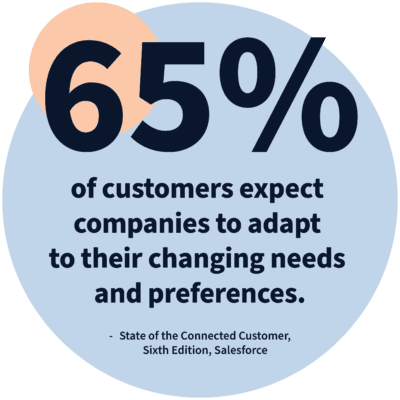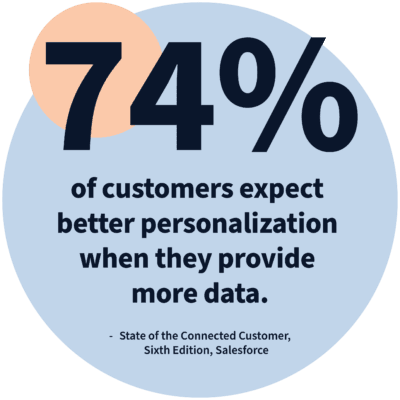For years, enterprises that gather customer data (read: pretty much all enterprises) have struggled to bring it together, assure its quality, and put it to use in improving customer engagement and sales. Today, this holy grail is better known as customer 360, which, as the phrase suggests, accomplishes those elusive goals by unifying, governing, and distributing customer data for use by client advisors and sales teams — without compromising data security and compliance. By embracing technologies and practices that achieve true customer 360, financial services, business services, and manufacturing enterprises are able to leverage a holistic view of each customer’s journey, paving the way for personalized engagement throughout the entire customer lifecycle.
“By 2026, 65% of B2B sales organizations will transition from intuition-based to data-driven decision making, using technology that unites workflow, data, and analytics.”
Gottlieb, Dan, et al., Market Guide for Sales Engagement Applications, Gartner, 27 March 2023
How Does Customer 360 Support Sales Engagement?
While simply achieving true customer 360 is a worthwhile goal, it’s every bit as important to understand its value in supporting sales engagement. By providing comprehensive insight into both prospects and customers, customer 360 gives advisors and sales teams the power to hyper-personalize outreach, identify upsell and cross-sell opportunities, improve targeting, coordinate cross-channel communications, and demonstrate measurable improvements in transaction and revenue growth.
In short, single-source-of-truth customer 360 — typically centralized in CRM — gives go-to-market teams the ability to have the right conversations with the right people at precisely the right time. Follow along to learn how customer 360 can help your enterprise to dramatically improve sales engagement.
“80% of customers say the experience a company provides is as important as its products and services.”
State of the Connected Customer, Sixth Edition, Salesforce
AI-fueled Customer Data Analysis and Data-driven Insights
Despite news of data-driven technologies designed to heighten productivity, the efforts of today’s client advisors and sales teams are often hindered by aging systems and counterintuitive tools that draw incomplete conclusions based on siloed, often low-quality data. As a result, teams lack current, reliable, actionable customer data analysis on current customer and market trends. This ultimately limits access to predictive intelligence that could inform cross- and upsell potential, improve customer engagement quality, and drive sales.
Fortunately, AI-enhanced revenue operations data integration tools like Riva Sync and Insight offer enterprises the means to seamlessly unify and govern siloed customer data. Put simply, these technologies bring the benefits of customer 360 to reality. Working with unified data, Riva’s Enterprise Analytics makes it possible to analyze enormous data samples and produce powerfully accurate information on how customers and prospects have engaged, and how best to serve their needs going forward. This kind of relationship intelligence empowers sellers to provide personalized customer recommendations, boosting both cross- and upsell opportunities while increasing customer confidence in the enterprise and its ability to serve their needs.
“Only 8% of B2B organizations are currently set up to deliver highly personalized marketing — but of that 8%, three-quarters report growing market share.”
Future of B2B Sales: The Big Reframe, Mckinsey & Company, November 2022
Automated Support for Omnichannel Engagement
While today’s client advisors and sellers routinely take part in one-to-one customer engagement, heightened productivity expectations also require the ability to maintain strong connections with multiple clients simultaneously. All too often, though, customer-facing teams are limited by poorly integrated customer data — and the lack of intuitive, effective tools to support scalable engagement.

Naturally, customer 360 is an integral part of the solution. By providing unified, single-source CRM access to unified, governed, high-quality customer information, sales teams have the comprehensive engagement history data they need to provide meaningful customer support. But in order to leverage the benefits of customer 360 at scale, sales teams also need the powerful, AI-enhanced relationship intelligence punch of outbound engagement tools like Riva Sales Engagement. Working with tools like Riva, sales teams can produce and share personalized content and content cadences with many customers via the channels they use. From AI-supported, large language model (LLM) content development capabilities to multi-channel communications templates, these solutions effectively amplify sales team efforts from one-to-one to one-to-many — without compromising engagement quality.
AI-enhanced Sales Content Optimization
It’s one thing to produce good content. It’s another altogether to produce highly individualized content that speaks to each customer’s needs — especially when it’s made available on the terms and channels those customers prefer.
Working with the benefits of customer 360, today’s sales teams are ideally positioned to deeply understand both prospects and customers. They’re able to see the person’s role, pain points, purchase history, support cases, and even their communication preferences. While those details can boost the impact of individual engagements, tools like Riva can amplify each sales team member’s engagement power from one-to-one to one-to-many.

…And we’re not talking about mass email. By harnessing the power of AI to capture the nuances of a single customer’s experience — or a like-minded group of customers — tools like Riva can help sales teams create targeted content and leverage multi-channel automation to make that content available on each customer’s terms.
Improved Cross-departmental Transparency and Seller Productivity
It’s simple logic, really: client advisors and sales teams are better positioned to perform at their highest, most productive potential when they have intuitive, single-source access to comprehensive, current, secure customer data. But customer 360 isn’t only about gaining customer insights. It’s also a means to encourage greater internal transparency — allowing uniform, uniform, governed access to secure, compliant customer data gathered throughout the enterprise.
In effect, customer 360 provides client advisors and sales teams with the complete customer picture — including sales interactions, deal sizes, churn risks, and customer lifetime value. Tools like Riva Bookings, Engagement Analytics, and Insight also automate data capture and unification, further reducing time spent on manual tasks. As a result, sellers are able to apply and amplify their experience by honing and distributing communications — both one-to-one and one-to-many — that reflect the collective customer wisdom of marketing, product development, finance, and more. By connecting these dots, sellers are better able to understand sales effectiveness and optimize their approaches to achieve pipeline growth and sales.
Experience the Transformative Sales Engagement Benefits of Customer 360
By unifying and governing high-quality customer data in single-source-of-truth CRM, customer 360 is the essential catalyst to leverage data’s potential — and dramatically improve sales engagement. Working with a comprehensive picture of each customer, tools like Riva allow client advisors and sales teams to amplify their efforts through targeted content creation and multi-channel content distribution. And because those efforts are supported by AI-enhanced data analysis, the impact of those communications advances customer conversations reaches the right audiences at the right time, improving customer relationships, retention, lifetime value, and sales.
To learn more about the amplifying power of Riva’s relationship and sales engagement platform — and to see how it can empower your client advisors and sales teams — we encourage you to contact us for a full demo.
Latest Articles
- What is Agentforce? Salesforce’s AI Agents Explained
- Digital Transformation in Banking: Trends, Challenges, and Future Insights
- Three Key Takeaways from Dreamforce San Francisco 2024
- What is AI Copilot in CRM: Detailed Guide with Examples
- Building a Strong Network of Salesforce Professionals at the Nebraska Summit
